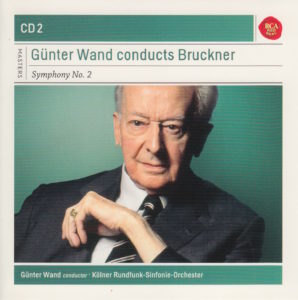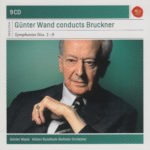 This morning’s conductor of Anton Bruckner’s “Symphony of Pauses” (Symphony No. 2 in C Minor, WAB 102) is German-born Gunter Wand (1912-2002).
This morning’s conductor of Anton Bruckner’s “Symphony of Pauses” (Symphony No. 2 in C Minor, WAB 102) is German-born Gunter Wand (1912-2002).
I first encountered Mr. Wand on Day 16.
To say I wasn’t kind in my assessment of his interpretation of Bruckner’s First Symphony is a wee bit of an understatement.
I’m hoping today’s performance is more to my liking.
Today is another milestone. After I’ve heard Gunter Wand’s interpretation of Bruckner’s Second Symphony, I will have heard Brucker’s first two symphonies from 16 different conductors, over a total of 32 straight days of listening to the works of this 19th century composer. Tomorrow morning starts the cycle all over again, only this time with Symphony No. 3 in D Minor and Daniel Barenboim at the helm.
For now, though, I have to focus on Gunter Wand.
So let’s dive right into the nuts and bolts of this morning’s recording:
 Bruckner’s Symphony No. 2 in C Minor, composed in 1872
Bruckner’s Symphony No. 2 in C Minor, composed in 1872
The version used is 1877, Haas edition
Gunter Wand conducts
Kolner Rundfunk-Sinfonie-Orchester plays
The symphony clocks in at 58.27
This was recorded in 1981 in Cologne, Germany
Wand was 69 when he conducted it
Bruckner was 48 when he composed it
This recording was released on RCA Red Seal/Sony label
Bruckner wrote his symphonies in four parts. The time breakdown of this one (Symphony No. 2 in C Minor, 1877, Haas edition), from this particular conductor (Wand) and this particular orchestra (Kolner Rundfunk-Sinfonie-Orchester) is as follows:
Ziemlich schnell………….19:07
Adagio…………………………15:42
Scherzo…………………………7:33
Finale…………………………..16:05
Total: 58:27
One thing I need to research is if the descriptor “Ziemlich schnell” is the same as “Moderato,” which is what I’ve been assuming all along. If that German phrase is not synonymous with the more common Italian one then I’ll have to go back to change things. I dislike being in error. It’s not difficult to do, though. There are so many things to pay attention to with this project! I hope whomever reads this will forgive my occasional mistakes. It’s not for lack of trying, I can assure you.
Also, yesterday’s (Day 31, Tintner) performance through me for a loop when I discovered that the version he used – the 1872 Original – placed the Scherzo second, rather than third. Now I have to go back to make sure I didn’t accidentally transpose the second and third movements when the Original 1872 version was used.
Details, details, details.
If God is in them, he sure likes to screw around with me.
Anyway, let’s just dive into the subjective aspects of this morning’s recording.
My Rating:
Recording quality: 4
Overall musicianship: 5
CD liner notes: 0 (there are none…boo! hiss!)
How does this make me feel: 4
What a difference a different symphony makes!
The last time I heard Gunter Wand I was nonplussed, even bored. In fact, I wrote this:
This recording bored me to tears. I listened to it three or four times through before I posted this.
It didn’t grow on me.
The orchestra sounds bored. The performance is lethargic. I could find neither highs nor lows, nothing that stirred my blood.
This time…wow.
I was captivated from the opening notes of the first movement.
It’s the same orchestra. Recorded the same year. In the same city in Germany. By the same conductor.
Yet, this time, I dig it.
How is that possible?
Three possibilities:
1. My mood is different this morning (so I’m hearing it and absorbing it differently),
2. Gunter Wand and the orchestra played with more exuberance this time,
3. There’s no difference and I just think there is
I have no idea.
All I know for sure is that this time around, Gunter Wand does it for me.
Go figure.
